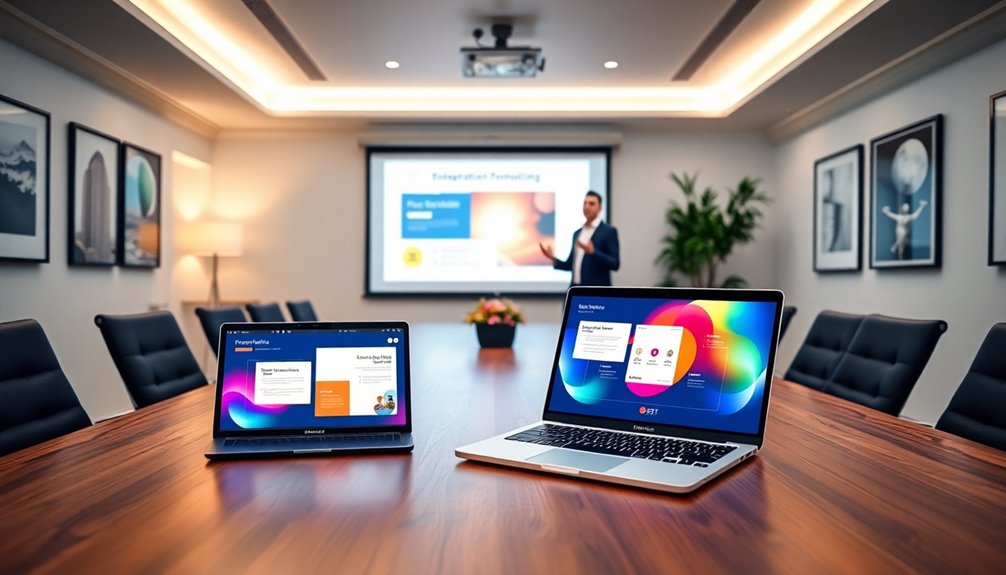Mastering your interview with presentation templates can make a real difference. These templates streamline your preparation, helping you organize your thoughts and showcase your knowledge effectively. You'll grab attention from the start with a strong title page and build credibility with a concise introduction. Utilize visuals to capture interest and keep your slides uncluttered. Practicing your delivery will build your confidence and guarantee smooth execution. Plus, engaging your audience with clear language and an invitation for questions at the end makes a lasting impression. There's much more to explore on enhancing your presentation skills and securing that job opportunity.
Key Takeaways
- Utilize presentation templates to streamline your interview preparation and reduce formatting stress.
- Incorporate a strong title page to capture the interviewer's attention from the start.
- Organize content with clear headings and bullet points for easy navigation and understanding.
- Enhance your presentation with credible sources and visuals to support your claims and engage the audience.
- Practice your delivery to build confidence and ensure a smooth, professional presentation during the interview.
Understanding Presentation Templates

When preparing for an interview, using presentation templates can greatly streamline your process.
These templates provide a predetermined outline that helps you organize your thoughts and ideas efficiently. If you're applying for a role that requires frequent presentations, having a solid template shows your knowledge and comfort in public speaking.
Not only do templates save you time and energy during preparation, but they also facilitate a logical flow of information. By following a structured approach, you can present your content effectively, making it easier for your audience to grasp your key points.
Plus, a well-prepared presentation can boost your confidence, allowing you to focus on delivering your message rather than stressing over the format.
Key Components of Effective Presentations

An effective presentation captivates your audience and communicates your message clearly. To achieve this, start with a strong title page that grabs attention and includes your name and the topic.
Your introduction should define the subject and establish your credibility. Break your content into manageable segments, using clear headings to guide your audience. Incorporate relevant sources to back your claims, ensuring your information is credible.
Use visuals like images and graphics to enhance understanding and engagement; they should complement your spoken words, not distract.
Finally, conclude with a summary of key points and invite questions to foster interaction. By focusing on these components, you'll create a compelling presentation that resonates with your audience. Additionally, consider leveraging on-device AI capabilities to personalize your presentation and engage your audience more effectively.
Structuring Your Presentation

Structuring your presentation effectively is essential for engaging your audience and conveying your message. Start with a clear title page that grabs attention, followed by a concise introduction.
In the introduction, define your topic and establish your qualifications to build credibility. Break down your content into manageable segments or slides, ensuring each section flows logically to the next. Use headings and bullet points to enhance clarity and keep your audience focused.
Conclude with a summary of key points, reinforcing your main arguments and their implications. Finally, invite questions to encourage interaction and express gratitude for your audience's time.
This structured approach not only enhances understanding but also leaves a lasting impression.
Enhancing Visual Appeal

To captivate your audience and reinforce your message, enhancing the visual appeal of your presentation is essential. Use eye-catching images and graphics, as they not only grab attention but also show your preparation effort. Standardizing your visual elements across slides guarantees consistency, making your presentation look polished. Here's a simple table to help you consider key visual components:
| Visual Element | Purpose |
|---|---|
| Bold Graphics | Grab immediate attention |
| One Image per Slide | Focus audience on a single idea |
| Consistent Color Scheme | Create a cohesive look |
| Clear Fonts | Enhance readability |
| Minimal Text | Keep slides uncluttered and impactful |
Incorporating bold graphics can create a powerful first impression, much like using a French press to produce a rich, full-bodied flavor in coffee.
Crafting a Strong Thesis Statement

Crafting a strong thesis statement is essential for guiding your presentation and ensuring your audience understands your main argument.
This statement should clearly define your main idea, typically placed at the end of your introduction. It serves as a roadmap for your audience, helping them follow your points and grasp your central message.
Your thesis needs to be specific and focused; avoid vague language or overly broad claims. As you develop your content, constantly align your points with this statement to maintain clarity and coherence. Additionally, showcasing your strong communication skills can further enhance how your thesis resonates with the audience.
Revising your thesis based on feedback can also enhance its effectiveness. Remember, a strong thesis sharpens your presentation and keeps you on track throughout your delivery.
Tips for Successful Delivery

Delivering a successful presentation is just as important as having a strong thesis statement. To engage your audience, practice your delivery until you feel confident.
Make eye contact and use natural gestures to emphasize points, creating a connection with listeners. Vary your tone and pace to maintain interest, and don't forget to pause for effect.
Use clear, concise language and avoid jargon that might confuse your audience. Remember to incorporate visuals effectively; they should support your message, not overshadow it.
Finally, invite questions at the end to encourage interaction and show your openness. With these tips, you'll convey your ideas powerfully and leave a lasting impression on your audience. Additionally, remember that storytelling techniques can enhance your presentation by making your message more relatable and impactful.
Additional Resources for Preparation

Preparing for an interview presentation can feel overwhelming, but utilizing the right resources can make a significant difference. By tapping into various materials, you can enhance your preparation and boost your confidence.
Consider exploring:
- Articles: Immerse yourself in "12 Tips for Delivering a Successful Interview Presentation" for practical advice.
- Templates: Use resources that outline effective presentation structures.
- Sample Questions: Review "37 Interview Questions for Business Managers" to anticipate potential inquiries.
- Feedback: Reach out for critiques from peers or mentors to refine your delivery.
Incorporating these resources not only aids in preparation but also helps you feel more equipped to handle the presentation, ensuring you make a positive impression. Additionally, applying data-driven decision-making can help you tailor your presentation to resonate with your audience effectively.
Frequently Asked Questions
How Do I Choose the Right Template for My Interview Presentation?
Choosing the right template for your interview presentation starts with understanding your audience and the topic.
Consider the type of role you're applying for and the expectations for visual aids. Look for a template that balances professionalism with creativity, ensuring it aligns with your message.
Make sure it's easy to customize, allowing you to incorporate your content seamlessly.
Ultimately, prioritize clarity and coherence to enhance your presentation's overall effectiveness.
Can I Customize a Presentation Template to Fit My Style?
Absolutely, you can customize a presentation template to fit your style!
Start by adjusting the color scheme and fonts to reflect your personality. Add your own images or graphics that resonate with your message.
Rearrange sections to better suit your flow and emphasize key points.
Remember, personalizing a template not only makes it more engaging but also helps you feel more comfortable and confident while presenting.
What Software Is Best for Creating Presentation Templates?
When creating presentation templates, you've got several great software options.
Microsoft PowerPoint is a classic choice, offering various design tools and templates.
Google Slides is perfect for collaboration and is user-friendly.
Canva provides stunning visuals and customizable templates, ideal for eye-catching designs.
Prezi offers a dynamic, non-linear presentation style that can engage your audience.
Choose the one that suits your needs and style, and start crafting impressive templates!
How Long Should My Interview Presentation Last?
Your interview presentation should ideally last between 10 to 20 minutes. This timeframe allows you to cover your topic thoroughly while keeping your audience engaged.
Start with a strong introduction, then present your key points clearly and concisely.
Make certain to leave a few minutes for questions at the end.
Practicing your timing beforehand will help you stay within this limit and guarantee you convey your message effectively.
What Should I Do if I Run Out of Time During My Presentation?
If you find yourself racing against the clock, it's like running a marathon with a sudden finish line.
Quickly identify the key points you need to cover and streamline your message. Skip any less critical details, and focus on summarizing your main ideas.
Invite questions to clarify anything important afterward. Remember to stay calm and confident; your audience will appreciate your ability to adapt under pressure.
Don't forget to express gratitude for their time!
Conclusion
By mastering presentation templates, you're like an artist with a canvas, ready to paint your ideas vividly for your audience. These tools not only streamline your preparation but also boost your confidence, allowing you to shine during your interview. Remember, a well-structured presentation can make all the difference, transforming a challenging task into an engaging experience. So, embrace these strategies, and you'll leave a lasting impression that sets you apart from the competition!
Eugene brings a fresh, dynamic voice to our platform as one of our talented Writers. Specializing in research-driven content, he explores the latest findings in psychology and personal growth, translating them into actionable insights for our readers. Eugene’s work is fueled by a curiosity about what makes us tick and a desire to help others unlock their potential.










